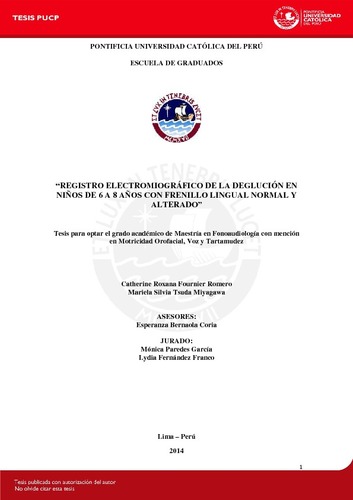| dc.contributor.advisor | Bernaola Coria, Esperanza | |
| dc.contributor.author | Fournier Romero, Catherine Roxana | es_ES |
| dc.contributor.author | Tsuda Miyagawa, Mariela Silvia. | es_ES |
| dc.date.accessioned | 2014-11-28T17:48:06Z | es_ES |
| dc.date.available | 2014-11-28T17:48:06Z | es_ES |
| dc.date.created | 2014 | es_ES |
| dc.date.issued | 2014-11-28 | es_ES |
| dc.identifier.uri | http://hdl.handle.net/20.500.12404/5770 | |
| dc.description.abstract | El objetivo de la presente investigación es determinar las diferencias entre los valores de la actividad muscular obtenidos a través de la electromiografía de superficie durante la función de deglución en niños de 6 a 8 años con frenillo lingual normal y alterado. Siendo un estudio de tipo cuanti-cualitativo con un diseño descriptivo comparativo, para lo cual la muestra seleccionada de manera intencional, estuvo conformada por 18 sujetos de ambos sexos del Colegio Assiri; 9 niños con frenillo lingual normal y 9 niños con frenillo lingual alterado. Ambos grupos fueron evaluados con los protocolos MBGR (2009), Protocolo de frenillo lingual y electromiografía de superficie en el Departamento de Diagnóstico del Centro Peruano de Audición, Lenguaje y Aprendizaje - CPAL.
La actividad de los músculos suprahiodeos, recogida a través de la electromiografía de superficie durante la deglución de saliva, deglución de 5ml de agua, deglución de 100ml de agua en forma habitual y durante posición de reposo y acoplamiento de la lengua al paladar, determinaron que tanto en los grupos con frenillo lingual normal como alterado, los sujetos presentan desequilibrio entre ambos lados de la musculatura; observándose una tendencia a presentar valores más elevados hacia el lado izquierdo de la musculatura suprahioidea.
Por tanto, se concluye que no existen diferencias significativas en la actividad muscular suprahioidea entre los sujetos con frenillo lingual normal y frenillo lingual alterado, ya que dicha diferencia se ve influenciada por la edad de los sujetos, los cuales se encuentran en la etapa de la dentición mixta. | es_ES |
| dc.description.abstract | The objective of this research is to determine the differences between the values of muscle activity obtained through surface electromyography during swallowing function in children between the ages of 6 and 8 with normal and altered lingual frenulum. Being a study with quantitative and qualitative comparative descriptive design, the selected sample intentionally consisted of 18 subjects of both sexes of Assiri College; 9 children with normal lingual frenulum and 9 children with altered lingual frenulum. Both groups were assessed with MBGR protocols (2009), lingual frenulum and surface electromyography Protocol in the Diagnostic Department of the Peruvian Center for Hearing, Language and Learning - CPAL.
The activity of the muscles suprahyoid, collected through surface electromyography during saliva swallowing, swallowing 5 ml of water, swallowing 100 ml water routinely and during rest position and attachment of the tongue to the palate, determined that both groups with normal and altered lingual frenulum had imbalance between both sides of the musculature; with a tendency to have higher values towards the left side of the suprahyoid musculature.
Therefore, it is concluded that there are no significant differences in the suprahyoid muscle activity between subjects with normal lingual frenulum and altered lingual frenulum, and that this difference is influenced by the age of the subjects, which are in the stage of mixed dentition. | es_ES |
| dc.language.iso | spa | es_ES |
| dc.publisher | Pontificia Universidad Católica del Perú | es_ES |
| dc.rights | Atribución-NoComercial-CompartirIgual 2.5 Perú | * |
| dc.rights | info:eu-repo/semantics/openAccess | es_ES |
| dc.rights.uri | http://creativecommons.org/licenses/by-nc-sa/2.5/pe/ | * |
| dc.subject | Trastornos de la deglución | es_ES |
| dc.subject | Electromiografía | es_ES |
| dc.subject | Deglución | es_ES |
| dc.title | Registro electromiográfico de la deglución en niños de 6 a 8 años con frenillo lingual normal y alterado | es_ES |
| dc.type | info:eu-repo/semantics/masterThesis | es_ES |
| thesis.degree.name | Magíster en Fonoaudiología con mención en Motricidad Orofacial, Voz y Tartamudez. | es_ES |
| thesis.degree.level | Maestría | es_ES |
| thesis.degree.grantor | Pontificia Universidad Católica del Perú. Escuela de Posgrado | es_ES |
| thesis.degree.discipline | Fonoaudiología con mención en Motricidad Orofacial, Voz y Tartamudez | es_ES |
| renati.discipline | 916127 | es_ES |
| renati.level | https://purl.org/pe-repo/renati/level#maestro | es_ES |
| renati.type | http://purl.org/pe-repo/renati/type#tesis | es_ES |
| dc.publisher.country | PE | es_ES |
| dc.subject.ocde | https://purl.org/pe-repo/ocde/ford#3.05.03 | es_ES |






